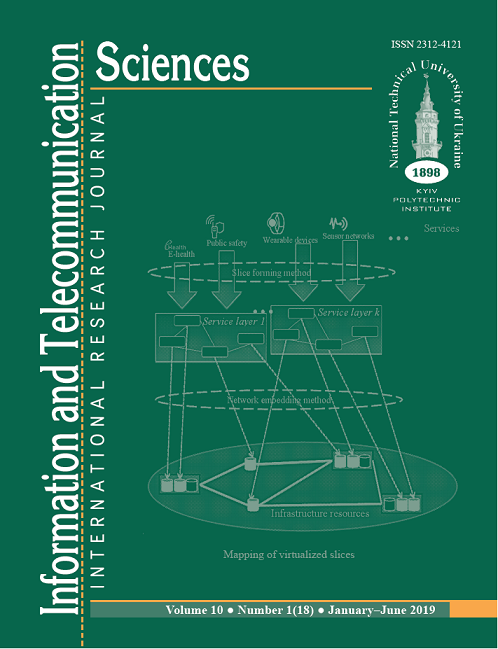AN APPROACH FOR VIRTUALIZED NETWORK SLICES PLANNING IN MULTISERVICE COMMUNICATION ENVIRONMENT
DOI:
https://doi.org/10.20535/2411-2976.12019.37-44Keywords:
mobile networks, network functions virtualization (NFV), slice, network slicing, 5G.Abstract
Background. Nowadays we face a huge growth in traffic of mobile networks due to the increased usage of smartphones and other mobile devices. To overcome these challenges and improve the efficiency of the network telecom operators use the advanced architectural solutions. These solutions are based on the concept of network slices.
Objective. In this paper the improving of the efficiency of mobile networks by forming and mapping slices of multi-service communication network based on network functions virtualization (NFV) is considered as an effective approach to resolve the mentioned above issues.
Methods. In order to find the optimal organization of slices the modified algorithm was proposed and performed for several different thresholds of functional losses.
Results. The algorithm solves the task of services grouping by their similarity and defines functional costs for services provision with minimum functional losses. Number of slices and functional losses in accordance with various threshold values were considered.
Conclusions. The results showed the possibility to rationally allocate system resources, especially when comparing to the similar approach. The further researches will be dedicated to more detailed analysis of the proposed approach with the aim of defining the optimal threshold values of functional losses.
References
Chester Johnston (2012).Signaling is growing 50% faster
than data traffic, http://docplayer.net/6278117-Signaling-is-growing-50-faster-than-data-traffic.html
Malla Reddy Sama, Xueli An, Qing Wei, Sergio Beker
(2016). Reshaping the mobile core network via function
decomposition and network slicing for the 5G Era. DOI:
1109/WCNCW.2016.7552681.
Liquid Core, http://networks.nokia.com/portfolio/liquidnet/liquidcore.
Larysa Globa, Mariia Skulysh, Svitlana Sulima (2016).
Method for resource allocation of virtualized network
functions in hybrid environment. DOI:
1109/BlackSeaCom.2016.7901546.
Margaret Chiosi (2012).Network Functions
Virtualisation, https://portal.etsi.org/NFV/NFV_White_Paper.pdf
M. Scharf, T. Voith, W. Roome, B. Gaglianello, M. Steiner, V. Hilt, and V. Gurbani (2012). Monitoring and abstraction for networked clouds. DOI:10.1109/ICIN.2012.6376038.
Network Slicing, https://www.ericsson.com/en/digitalservices/
trending/network-slicing
F. Z. Yousaf, M. Gramaglia, V. Friderikos, B. Gajic et al
(2017). Network slicing with flexible mobility and QoS/QoE support for 5G Networks. DOI:10.1109/ICCW.2017.7962821.
Kai Han, Shengru Li, Shaofei Tang, Huibai Huang,
Sicheng Zhao (2018). Application-Driven End-to-End
Slicing: When Wireless Network Virtualization Orchestrates With NFV-Based Mobile Edge Computing,
https://ieeexplore.ieee.org/abstract/document/8356658.
N. Chowdhury et al. (2009). "Virtual Network
Embedding with Coordinated Node and Link Mapping", pp. 783-91.
Zhengfa Li, Zebin Lu, Shuhua Deng, Xieping Gao (2019). Customizable Function Chains: Managing Service Chain Variability in Hybrid NFV Networks, https://ieeexplore.ieee.org/stamp/stamp.jsp?tp=&arnumb
er=8672853.
Zhengfa Li, Zebin Lu, Shuhua Deng, Xieping Gao
(2018). A Self-Adaptive Virtual Network Embedding
Algorithm Based on Software-Defined Networks,
https://ieeexplore.ieee.org/document/8496853.
Hendrik Moens, Filip De Turck (2016). Customizable
Function Chains: Managing Service Chain Variability in
Hybrid NFV Networks,
https://ieeexplore.ieee.org/document/7491361.
T. Shimojo, M. R. Sama, A. Khan, S. Iwashina (2017).
Cost-efficient method for managing network slices in a multi-service 5G core network. DOI:10.23919/INM.2017.7987451.
Downloads
Published
How to Cite
Issue
Section
License
The ownership of copyright remains with the Authors.
Authors may use their own material in other publications provided that the Journal is acknowledged as the original place of publication and National Technical University of Ukraine “Igor Sikorsky Kyiv Polytechnic Institute” as the Publisher.
ITS articles are published under Creative Commons licence:
- Authors retain copyright and grant the journal right of first publication with the work simultaneously licensed under CC BY 4.0that allows others to share the work with an acknowledgement of the work's authorship and initial publication in this journal.
- Authors are able to enter into separate, additional contractual arrangements for the non-exclusive distribution of the journal's published version of the work (e.g., post it to an institutional repository or publish it in a book), with an acknowledgement of its initial publication in this journal.
- Authors are permitted and encouraged to post their work online (e.g., in institutional repositories or on their website) prior to and during the submission process, as it can lead to productive exchanges, as well as earlier and greater citation of published work.

